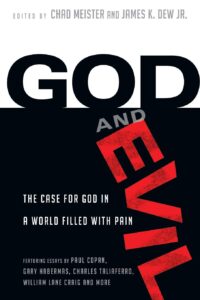This book is a collection of essays by over twenty different authors. Some of the authors are well-known, such as Bruce Little, Gary Habermas, and William Lane Craig. Needless to say, this review will not cover each individual essay. Rather, it will give a general overview of the book and identify common themes found throughout the different essays.
The question, or problem, of evil has been something which Christians have wrestled with since the beginning. As Christians, we hold that God himself is 100% holy and good, and yet evil abounds in the world. “The problem is that these two claims seem to conflict” (9). There are many questions which arise: “If God really exists, why is there evil? Where did it come from? And why doesn’t God eliminate it? Does he not want the removal of evil? Is he unable to do it? Is God disinterested in the troubles of our world?” (9). The goal of this book is “to provide reasonable answers to these kinds of questions and to present various ways evangelical Christians have wrestled with the issues” (9).
This book is written by various evangelical authors, and some of the questions addressed in this book are handled by Lutherans differently and perhaps more adequately. However, there is much value in reading how other Christians view and handle the problem of evil. It gives us practical insights into their hermeneutic and can help us navigate conversations with others.
Evaluation
A single evaluation of arguments cannot be handled in this review, since there are many authors. However, there are many themes (or lack thereof) which reoccur as the authors tackle the problem of evil. The topic of free will occurs over and over again as to why it was possible for evil to enter creation in the first place. It is interesting to note that many Christians continue to have a libertarian view of free will (true freedom in moral choices even after the Fall). This is at odds with Scripture’s description of the corruptness of humanity as well as Luther’s view of the will.
There was an extreme lack of talk of original sin and total depravity among humanity in this book. The Fall was mentioned, but rarely along with the true ramifications of it. It seemed as if the authors would focus on the Fall along with free will and how evil came into existence, but failed to touch on those topics as a reason for continued and gratuitous evil in the world.
The authors took two different approaches to the problem of evil: either defense or theodicy. A defense “is an attempt to show that there is no logical incompatibility between the existence of evil and the existence of God…. A theodicy, on the other hand, attempts to demonstrate that for every evil that exists, there is a morally sufficient reason for God’s allowing it to exist” (9). In my opinion, the defense approach is preferable. The theodicy approach tends to come across as trying to peer into the mind of God. It also seemed difficult for those authors who used the theodicy approach to adequately make their argument. It seemed that their arguments fell flat or came across as too intricate and convoluted.
Overall, as the chapters progressed, it was not a simple re-hashing of the exact same topic. There were nuanced views taken. For example, chapter 11, entitled Evil and Prayer, had good and practical insights on using prayer in times of trouble and distress. Chapter 12, entitled Evil in Non-Christian Religions, looked at how Islam, traditional religions, Zoroastrianism, Hinduism, Buddhism, Jainism, and Chinese thought each approach the problem of evil. This section was particularly interesting, since evil is a problem for all religions and not only Christianity. Though a short chapter, and only an overview of what these religions teach about evil, it was very interesting and helpful to get a more comprehensive view of the problem of evil.
Uses in Ministry
This book will be helpful in enabling the pastor (or any Christian) to be able to converse with skeptics in regard to the existence of evil in the world. Again, a major element in the different approaches to the problem of evil is that of the will. Most of the authors in this book take the view that humanity still has free will in moral choices. It seems that Lutheranism can bring some valuable insights to the table in regard to this topic, namely the sinner-saint condition of humans, total depravity, and original sin.
The essays in this book are helpful to thoroughly think through the problem of evil as well as other parts of systematic theology. The problem of evil can be a significant stumbling block for skeptics of Christianity and is an issue that mature Christians can wrestle and struggle with. As the pastor grows in his understanding of different approaches to the problem of evil, he will be more well-equipped to address concerns and questions of lay-members.
Conclusion
This book’s strengths lie in its wide array of authors of different evangelical backgrounds and approaches to handling evil. The essays are well-written and sufficiently cover the different nuances of the topic without being redundant. This book would also be helpful in doing a Bible study on the problem of evil and helping lay-members understand the different approaches along with their benefits and shortcomings. One weakness is that it fails to offer a view of the will that takes into account the fallen nature of man as well as the Christian’s new creation in Christ. This would hit on the topic of personal evils people commit (sin) which would be of benefit to understanding the larger problem of evil. Overall, I would definitely recommend reading this book.


